Virtual Reality (VR) Market Size, Share & Industry Growth Analysis Report by Technology (Non-immersive, Semi & Fully Immersive), Offering, Device Type (Head-mounted Devices, Gesture Tracking Devices, Projectors & Display Walls), Application and Region - Global Forecast to 2029
The global virtual reality (VR) market size is estimated to be USD 15.9 billion in 2024 and projected to reach USD 38.0 billion by 2029, growing at a CAGR of 19.1% during the forecast period. The growing penetration of the metaverse and Significant adoption of HMDs across various sectors are attributed to the ever-increasing demand for virtual reality system.
Attractive opportunities in the virtual reality market
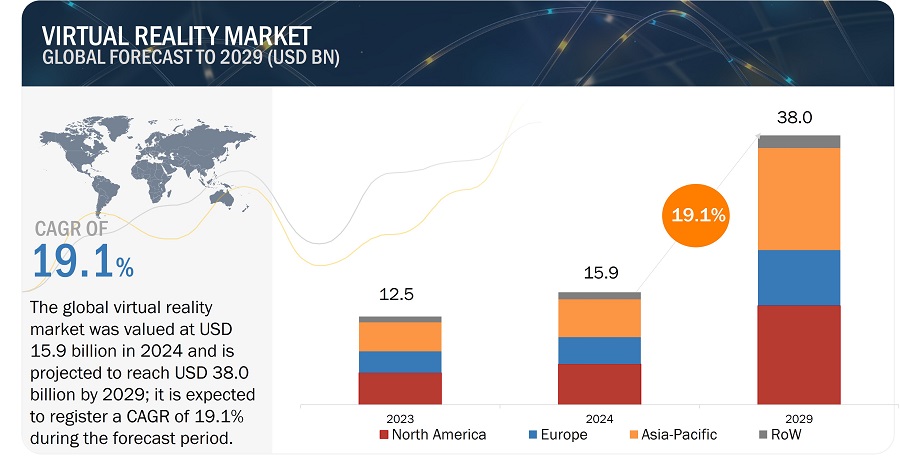
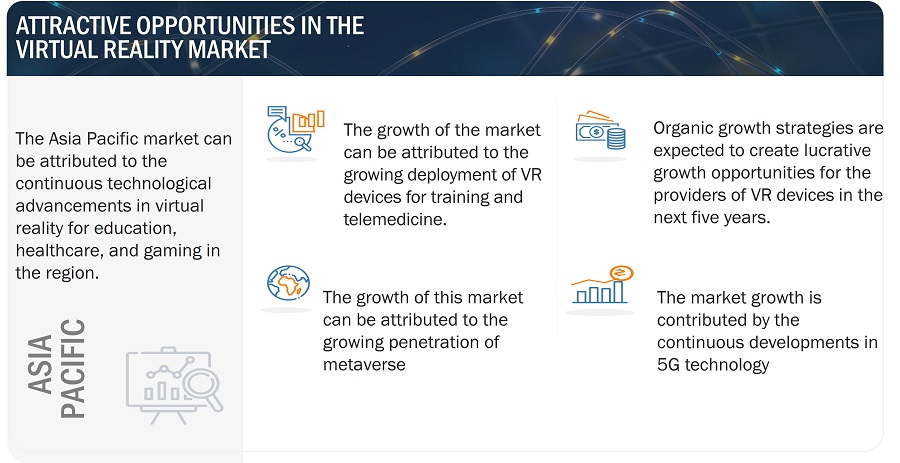
Virtual Reality Market Forecast to 2029
To know about the assumptions considered for the study, Request for Free Sample Report
Virtual Reality (VR) Market Dynamics:
Driver: The growing penetration of the Metaverse
The metaverse is all about creating a sense of presence in a virtual world. Virtual Reality (VR) technology is at the forefront of the metaverse, providing immersive experiences that blur the lines between reality and the virtual world. VR headsets, such as Meta’s Oculus, offer a 360-degree view of virtual worlds, replacing the user’s view of the outside world. This technology has already contributed significantly to various industries, including education, healthcare, and customer service. VR has been shown to improve learning and increase accuracy in medical practice, making it a valuable tool for training and education. Immersive experiences in the metaverse, particularly those powered by VR, have the potential to revolutionize the way we work, learn, and socialize.
To access the metaverse, users will require immersive devices like VR headsets, smart glasses, augmented reality (AR) devices, or even smartphones and tablets. VR is one of the mediums that will let users connect with the metaverse, but it is only one part of the implicit concept. The metaverse is a platform that comprises VR as one of its features, delivering a cross-platform experience that enables users to interact with people globally in the virtual world.
For instance, in April 2024, Metaverse911 (India), a metaverse research and advisory firm launched Metaverse Experience Center (MEC) in Noida (India). The MEC is designed to serve as the hub for showcasing cutting-edge AR, VR, Mixed Reality (MR), Digital Twin, and Metaverse solutions, creating a unique space for industry leaders to explore and experience the latest developments in immersive technologies.
Restraint: Latency issues and high energy consumption
The efficacy of virtual reality devices hinges upon a delicate balance between various technical factors, with latency in display and energy consumption emerging as pivotal determinants of their overall performance. Latency, referring to the delay between user input and the corresponding visual response in the virtual reality environment, has the potential to disrupt the seamless immersion that virtual reality strives to achieve. Even the slightest delay can lead to motion sickness, discomfort, and a perceptible detachment from the virtual world.
On the other hand, the energy consumption of virtual reality devices plays a critical role in determining the practicality and user experience. High energy demands can lead to shorter battery life, necessitating frequent recharges and limiting the duration of immersive experiences. This not only impacts user convenience but also constrains the scope of applications, particularly in scenarios where uninterrupted usage is essential, such as extended training simulations or immersive educational modules.
Both latency and energy consumption are intertwined, as addressing one often influences the other. Mitigating latency requires rapid data processing, which can strain the device’s hardware and subsequently increase energy usage. Conversely, optimizing energy efficiency might involve lowering processing speeds, inadvertently introducing latency. This intricate interplay highlights the intricate trade-offs virtual reality developers must navigate.
Overcoming these challenges requires advancements in display technology, computational efficiency, and battery capacity. Cutting-edge displays with higher refresh rates can reduce latency, while energy-efficient hardware design and software optimization can prolong usage time. As the virtual reality industry matures, technological innovation in these areas is expected to be pivotal in crafting a virtual reality experience that is both immersive and sustainable, ensuring that the impact of latency and energy consumption on overall effectiveness is minimized.
Opportunity: Continuous developments in 5G technology
The adoption of virtual reality technology has been gaining momentum in both personal and professional applications. The advent of the 5G technology is expected to address some challenges by paving the way for optimized distribution of processing capabilities. 5G's enhanced performance enables faster and more reliable connections, leading to an improved user experience in VR applications. The technology's higher data transfer rates and lower latency result in responsive VR experiences, while enhanced visuals allow for the streaming of higher-resolution content and complex 3D graphics in real time. The capabilities of 5G open up new use cases for VR, such as real-time cloud rendering and edge computing, enabling complex and data-intensive applications like virtual tourism and smart city simulations.
For instance, in May 2023, Telefónica S.A. (Spain) partnered with Atlético de Madrid, a Spanish professional football club, to implement a new immersive way of enjoying matches via 5G and in Virtual Reality (VR). This is a new way of watching football matches through the 5G Multicam project, which allows fans to enjoy a 360° real-time experience of the match from various angles, including behind the goal, the tunnel exit, the press area, or the stadium control room.
Challenge: Creating VR systems with user-friendly interface
The challenge of developing a virtual reality system with a user-friendly interface delves into the intricate balance between immersive technology and intuitive usability. While the potential of Virtual Reality to transport users to new dimensions is exhilarating, the complexity of integrating intricate hardware, sophisticated software, and natural interaction demands careful consideration.
In crafting a user-friendly virtual reality system, designers must grapple with multifaceted elements. Firstly, the interface should seamlessly guide users through the experience, ensuring that interactions feel intuitive and natural. Complex menus, intricate gestures, and challenging controls can hinder the sense of immersion, disconnecting users from the virtual environment they seek to explore.
Secondly, comfort is paramount. Prolonged virtual reality use can lead to discomfort, motion sickness, and fatigue. Developing an interface that minimizes these negative effects requires understanding how visual cues, motion tracking, and sensory inputs align with the user’s physiological response.
Content accessibility must not be compromised. Users, regardless of technical expertise, should be able to access and navigate virtual reality content effortlessly. Striking this balance is a challenge, especially as virtual reality applications expand into diverse industries and user demographics.
Addressing these challenges involves iterative design, user testing, and collaboration among experts in human-computer interaction, interface design, and ergonomics. As the virtual reality landscape matures, the successful resolution of this challenge ensures that immersive experiences are not just exhilarating but also inclusive, comfortable, and easily navigable for a wide spectrum of users.
Creating a user-friendly virtual reality interface involves a combination of thoughtful design, usability testing, and ongoing refinement. Prioritizing user experience and accessibility will contribute to the success of the virtual reality system and enhance user satisfaction, ultimately making virtual reality technology more accessible and enjoyable for a broader audience.
Virtual Reality (VR) Market Analysis
Virtual Reality (VR) Market Trends
Virtual Reality (VR) Market Ecosystem
Prominent companies in this market include well-established, financially stable providers of virtual reality systems. These companies have been operating in the market for several years and possess a diversified product portfolio, state-of-the-art technologies, and strong global sales and marketing networks. Prominent companies in this market include Meta (US), Sony (Japan), Samsung Electronics Co., Ltd. (South Korea), Microsoft (US), Unity Technologies (US), Barco (Belgium), Penumbra, Inc. (US), HTC Corporation (Taiwan), PICO Immersive Pte.ltd (US), and DPVR (China).
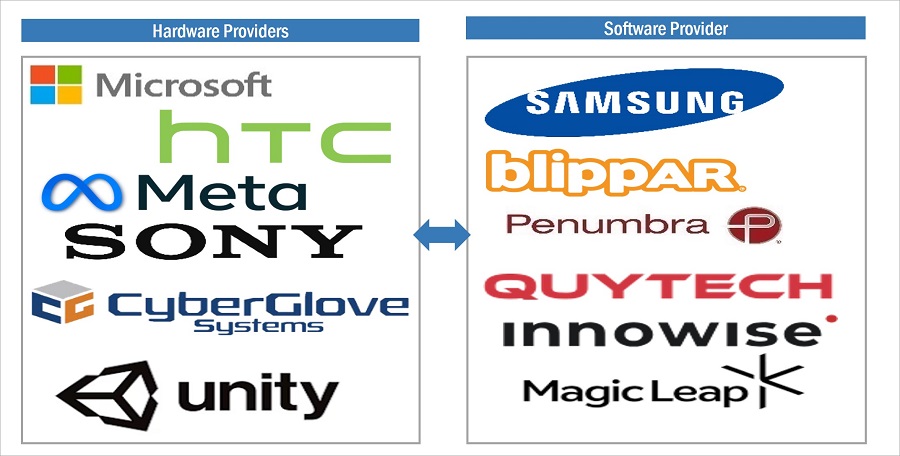
Virtual Reality (VR) Market Segementation:
By offering, hardware segment is expected to grow with the highest CAGR from 2024 to 2029.
The hardware segment is expected to grow at a higher CAGR of 22% during the forecast period. The growth for hardware segment is anticipated to the demand of VR headsets popularity in gaming, providing an immersive experience that is unmatched by traditional monitors. With the growing popularity of esports and the rising demand for more realistic gaming experiences, VR hardware is expected to see continued growth.
By device type, gesture tracking devices segment is expected to grow with the highest CAGR in 2029.
The Gesture Tracking Devices are expected to record a highest CAGR of 25.2% during the forecast period. Gesture tracking allows for a more natural and intuitive way to interact with the virtual world. By using your hands and body movements to control objects and navigate environments, you feel a deeper sense of presence within the VR experience. This is a major advantage over traditional controllers, which can feel clunky and break immersion.
The advancement of machine learning and computer vision techniques has led to the development of more accurate and robust gesture recognition algorithms. These algorithms can better understand and interpret complex hand and body movements, enabling more intuitive and natural interactions with the virtual environment.
Virtual Reality (VR) Market Growth:
By technology, the Semi & Fully Immersive segment is expected to grow with the highest CAGR from 2024 to 2029.
The Semi & Fully Immersive segment is expected to exhibit a higher CAGR of 19.6% during the forecast. Fully immersive technology provides a high level of immersion, where users feel completely transported into a digital environment, often to the extent that they lose awareness of their physical surroundings.This level of immersion is typically achieved through advanced hardware like high-quality virtual reality headsets and motion-tracking systems that accurately replicate users’ movements in the virtual world.
Semi-immersive technology offers a moderate level of immersion in a digital environment. Users typically interact with these systems using some form of interface, such as a computer screen, projection, or a smaller-scale immersive device like a head-mounted display or Cave Automatic Virtual Environment (CAVE).
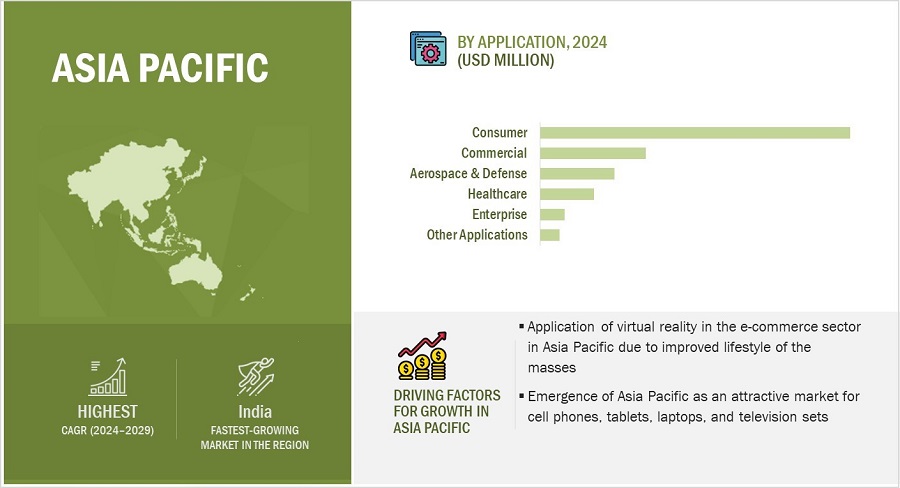
Virtual Reality Market by Region
To know about the assumptions considered for the study, download the pdf brochure
Virtual Reality (VR) Market: Regional Analysis
In 2029, Asia Pacific is projected to hold the highest CAGR of the overall virtual reality market.
In 2029, The virtual reality market in Asia Pacific is expected to grow at the highest CAGR. The Asia Pacific virtual reality market is experiencing significant growth due to the rise of eSports and immersive gaming experiences is a major driver. VR offers a new level of engagement for gamers, and the growing popularity of eSports fuels the demand for VR. Significant players from the region Sony (Japan), Samsung Electronics Co., Ltd. (South Korea), DPVR (China), FOVE, Inc (Japan), Vection Technologies (Australia), and Vighnesh Inc. (India).
Virtual Reality (VR) Industry Overview
The virtual reality (VR) market is rapidly evolving, driven by technological advancements and increasing adoption across diverse sectors. Standalone VR headsets are popular for their convenience and mobility. While gaming remains a key driver, VR is expanding into education, healthcare, and enterprise for applications like training, therapy, and design simulations. Improvements in AI and haptic feedback are enhancing the user experience. As VR technology becomes more affordable and content libraries grow, the market is poised for widespread adoption and new business opportunities.
Top Virtual Reality (VR) Companies - Key Market Players
- Meta (US),
- Sony (Japan),
- Samsung Electronics Co., Ltd. (South Korea),
- Microsoft (US),
- Unity Technologies (US),
- Barco (Belgium),
- Penumbra, Inc. (US),
- HTC Corporation (Taiwan),
- PICO Immersive Pte.ltd (US), and
- DPVR (China) are some of the key players in the virtual reality companies.
Virtual Reality (VR) Market Report Scope
|
Report Metric |
Details |
| Estimated Market Size | USD 15.9 billion in 2024 |
| Projected Market Size | USD 38.0 billion by 2029 |
| Virtual Reality (VR) Market Growth Rate | CAGR of 19.1% |
|
Market Size Availability for Years |
2020–2029 |
|
Base Year |
2023 |
|
Forecast Period |
2024–2029 |
|
Forecast Units |
Value (USD Million/Billion) |
|
Segments Covered |
By technology, offering, device type, application, and region |
|
Geographies Covered |
North America, Europe, Asia Pacific, and RoW |
|
Companies Covered |
Meta (US), Sony (Japan), Samsung Electronics Co., Ltd. (South Korea), Microsoft (US), Unity Technologies (US), Barco (Belgium), Penumbra, Inc. (US), HTC Corporation (Taiwan), PICO Immersive Pte.ltd (US), and DPVR (China) are some of the key players in the virtual reality market. |
Virtual Reality Market Highlights
This research report categorizes the virtual reality market based technology, offering, device type, application, and region.
|
Segment |
Subsegment |
|
By Technology |
|
|
By Offering |
|
|
By Device Type |
|
|
By Application |
|
|
By Region |
|
Recent Developments in Virtual Reality (VR) industry
- In December 2023, DPVR collaborated with SchooVR, provider of immersive educational content. The collaboration between DPVR and SchooVR aims to enhance learning solutions for teachers and students by integrating virtual reality (VR) into the classroom environment.
- In October 2023, Sony unveiled PlayStation 5 Slim version. It's a redesigned version of the original PS5 that's smaller and lighter, with a few other improvements. The PS5 Slim is about 30% smaller in volume than the original PS5. It's also lighter, making it easier to transport and fit into entertainment centers.
- In October 2023, DPVR introduced E4C headset is an ideal choice for VR rotation chairs, shooting and fighting games, and other large group applications. The DPVR E4C is designed for simulation training, allowing users to learn how to operate equipment, drive a vehicle, or fly an aircraft through virtual reality
- In September 2023, DPVR launched P2, a virtual reality headset designed for PC use. It boasts stereo speakers, a longer detachable cable, and a leather faceliner, making it suitable for traffic use and supporting FEC owners in business transformation and revenue growth.
- In February 2023, Sony introduced PlayStation VR2, it features high fidelity visuals, new sensory features, and enhanced tracking, providing gamers with extraordinary experiences. The headset includes an OLED display with a resolution of 2000 x 2040 pixels per eye, a 110-degree field of view, and foveated rendering. It also incorporates innovative technology like the PlayStation VR2 Sense controller, 3D Audio, and eye tracking to enhance sensory features during gameplay.
Frequently Asked Questions (FAQs):
Which are the major companies in the virtual reality (VR) market? What are their major strategies to strengthen their market presence?
The major companies in the virtual reality market are – Meta (US), Sony (Japan), Samsung Electronics Co., Ltd. (South Korea), Microsoft (US), Unity Technologies (US), Barco (Belgium), Penumbra, Inc. (US), HTC Corporation (Taiwan), PICO Immersive Pte.ltd (US), and DPVR (China) and the major strategies adopted by these players are product launches and developments.
What is the virtual reality device?
A virtual reality (VR) device is a headset that creates an immersive, three-dimensional experience. VR headsets typically include a stereoscopic display (providing separate images for each eye), stereo sound, and sensors like accelerometers and gyroscopes for tracking the pose of the user's head to match the orientation of the virtual camera with the user's eye positions in the real world.
Who are the winners in the global virtual reality market?
Companies such as Meta (US), Sony (Japan), Samsung Electronics Co., Ltd. (South Korea), Microsoft (US), Unity Technologies (US), fall under the winner’s category. These companies cater to the requirements of their customers by providing virtual reality systems. Moreover, these companies are highly adopting inorganic growth strategies to strengthen their global market position and customer base.
What are the drivers and opportunities for the virtual reality market?
The growing penetration of the Metaverse is the driver, and Continuous developments in 5G technology is the opportunity in the virtual reality market.
What are the restraints and challenges for the virtual reality market?
Continuous developments in 5G technology and Continuous developments in 5G technology are the restraints and challenges in the virtual reality market.
To speak to our analyst for a discussion on the above findings, click Speak to Analyst
The study involved four major activities in estimating the size of the virtual reality market. Exhaustive secondary research has been carried out to collect information on the market, the peer markets, and the parent market. Both top-down and bottom-up approaches have been employed to estimate the total market size. Market breakdown and data triangulation methods have also been used to estimate the market for segments and subsegments.
Secondary Research
Revenues of companies offering virtual reality systems have been obtained from the secondary data available through paid and unpaid sources. The revenues have also been derived by analyzing the product portfolio of key companies, and these companies have been rated according to the performance and quality of their products.
In the secondary research process, various sources have been referred to for identifying and collecting information for this study on the virtual reality market. Secondary sources considered for this research study include government sources, corporate filings, and trade, business, and professional associations. Secondary data has been collected and analyzed to arrive at the overall market size, which has been further validated through primary research.
Secondary research has been mainly used to obtain key information about the supply chain of virtual reality systems to identify key players based on their products and prevailing industry trends in the virtual reality market by technology, type, product type, end-user industry, and region. Secondary research also helped obtain market information- and technology-oriented key developments undertaken by market players to expand their presence and increase their market share.
Primary Research
Extensive primary research has been conducted after understanding and analyzing the current scenario of the virtual reality market through secondary research. Several primary interviews have been conducted with the key opinion leaders from the demand and supply sides across four main regions—North America, Europe, Asia Pacific, and the Rest of Europe. Approximately 25% of the primary interviews were conducted with the demand-side respondents, while approximately 75% were conducted with the supply-side respondents. The primary data has been collected through questionnaires, emails, and telephone interviews.
After interacting with industry experts, brief sessions were conducted with highly experienced independent consultants to reinforce the findings from our primary. This, along with the in-house subject matter experts’ opinions, has led us to the findings as described in the remainder of this report. The breakdown of primary respondents is as follows:
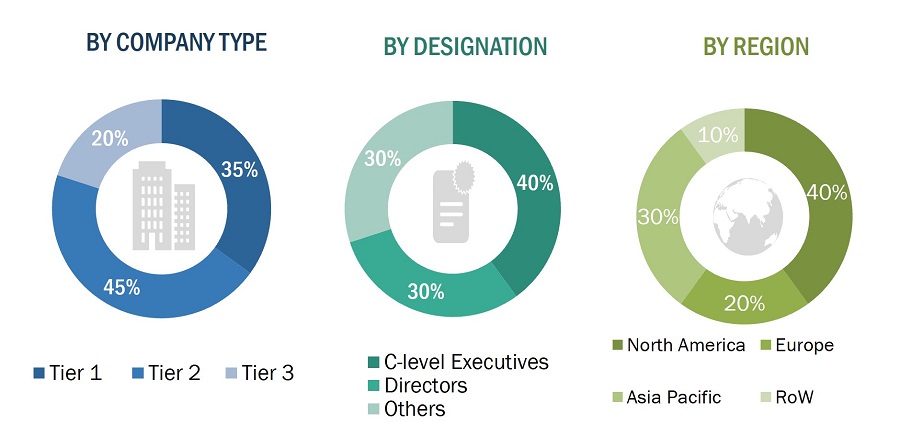
To know about the assumptions considered for the study, download the pdf brochure
Market Size Estimation
The bottom-up procedure has been employed to arrive at the overall size of the virtual reality market.
- Identifying application wherein virtual reality systems are deployed or are expected to use
- Analyzing major providers of virtual reality equipment’s and original equipment manufacturers (OEMs), as well as studying their portfolios and understanding different technologies used
- Analyzing the average selling price of virtual reality systems powered by different technologies
- Arriving at the market estimates by analyzing the revenue of companies and then combining these figures to arrive at the market size
- Studying various paid and unpaid sources, such as annual reports, press releases, white papers, and databases, to gather the required information
- Tracking the ongoing developments and identifying the upcoming developments in the market that include investments, research and development activities, product launches, contracts, collaborations, and partnerships undertaken, and forecasting the market size based on these developments
- Carrying out multiple discussions with key opinion leaders to understand the types of virtual reality products, services, and software designed and developed, thereby analyzing the break-up of the scope of work carried out by the major companies in the virtual reality market
- Arriving at the market estimates by analyzing the revenue generated by key companies providing virtual reality products on the basis of their locations (countries) and then combining the market size for each country to get the market estimate by region
- Verifying and crosschecking the estimates at every level by discussing with key opinion leaders, including CXOs, directors, and operation managers, and then finally with the domain experts at MarketsandMarkets
- Studying various paid and unpaid sources of information, such as annual reports, press releases, white papers, and databases
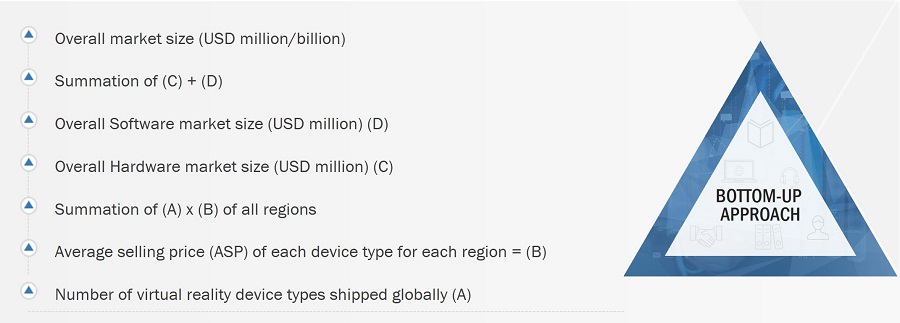
The top-down approach has been used to estimate and validate the total size of the virtual reality market.
- Focusing on top-line investments and expenditures being made in the ecosystems of various applications
- Calculating the market size, considering revenues from major players through the cost of virtual reality systems
- Segmenting each application of the virtual reality system in each region and deriving the global market size based on the region
- Acquiring and analyzing information related to revenues generated by players through their crucial product offerings
- Conducting multiple on-field discussions with key opinion leaders involved in developing various virtual reality solutions
- Estimating geographical splits by using secondary sources on the basis of various factors, such as the number of players in a specific country and region, types of virtual reality products/solutions, and levels of services offered across several application

Data Triangulation
After arriving at the overall market size-using the market size estimation processes as explained above-the market has been split into several segments and subsegments. To complete the entire market engineering process and arrive at the exact statistics of each market segment and subsegment, data triangulation and market breakdown procedures have been employed, wherever applicable. The data has been triangulated by studying various factors and trends from the demand and supply sides in the virtual reality market.
Market Definition
Virtual Reality (VR) is a simulated experience that employs 3D near-eye displays and pose tracking to give the user an immersive feel of a virtual world. It creates simulated environments that can be similar to or entirely different from the real world, with applications in entertainment, education, healthcare, and marketing These environments are designed to be immersive and interactive, allowing users to feel like they are truly present within the virtual world. VR typically utilizes headsets with near-eye displays and tracking mechanisms to create a sense of movement and position within the simulation. It can also incorporate other sensory elements like sound and haptics to further enhance the experience.
Key Stakeholders
- Raw material and manufacturing equipment suppliers
- Semiconductor foundries
- Original equipment manufacturers (OEMs)
- Augmented reality and virtual reality device manufacturers
- Original design manufacturers (ODMs) and OEM technology solution providers
- Research organizations
- Technology standard organizations, forums, alliances, and associations
- Technology investors
- Governments, financial institutions, and investment communities
- Analysts and strategic business planners
Report Objectives
- To describe and forecast the size of the virtual reality market, by technology, offering device type, application, and region, in terms of value
- To describe and forecast the market size of various segments across four key regions—North America, Europe, Asia Pacific, and Rest of the World (RoW), in terms of value
- To forecast the size of the virtual reality market by device type, in terms of volume
- To provide detailed information regarding the drivers, restraints, opportunities, and challenges influencing the growth of the virtual reality market
- To analyze the virtual reality value chain and ecosystem, along with the average selling price of virtual reality systems
- To strategically analyze the regulatory landscape, tariff, standards, patents, Porter’s five forces, import and export scenarios, trade values, and case studies pertaining to the market under study
- To strategically analyze micromarkets1 with regard to individual growth trends, prospects, and contributions to the overall market
- To analyze opportunities in the market for stakeholders by identifying high-growth segments
- To provide details of the competitive landscape for market leaders
- To analyze strategies such as product launches, expansion, collaborations, acquisitions, partnerships, and expansions adopted by players in the virtual reality market
- To profile key players in the virtual reality market and comprehensively analyze their market ranking based on their revenue, market share, and core competencies2
Available customizations:
With the given market data, MarketsandMarkets offers customizations according to the specific requirements of companies. The following customization options are available for the report:
- Detailed analysis and profiling of additional market players based on various blocks of the supply chain











Growth opportunities and latent adjacency in Virtual Reality (VR) Market
Hi, I wanted to understand the VR market in Asia. Could you please share a sample?
Valorizar Economicamente el crecimiento del Mercado de Realidad Virtual los próximos 5 años